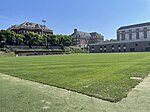Oakwood High School (Ohio)
Oakwood High School(OHS) is a public secondary school in Oakwood, Montgomery County, Ohio. As of the 2023-2024 school year, there are around 700 students The school mascot is the Lumberjack, with male students being referred to as "Lumberjacks" or "Jacks" and female students usually being referred to as "Lumberjills" or "Jills" with a female "Lumberjill" mascot appearing at most female sporting events. Oakwood was named A National Blue Ribbon School by the U.S. Department of Education in 1990-91 and 2007. In the 21-22 school year, Oakwood was ranked second in the state on the Ohio Department of Education's High School Performance Index. Additionally, U.S. News in 2023 ranked Oakwood as the 905st best public high school in the nation.In 2024, Oakwood City Schools Superintendent Neil Gupta announced that Principal Paul Waller was being placed on administrative leave and Patrick Masters would be serving as the schools interim Principal.
Excerpt from the Wikipedia article Oakwood High School (Ohio) (License: CC BY-SA 3.0, Authors).Oakwood High School (Ohio)
South Main Street,
Geographical coordinates (GPS) Address Nearby Places Show on map
Geographical coordinates (GPS)
| Latitude | Longitude |
|---|---|
| N 39.720905 ° | E -84.171777 ° |
Address
Oakwood Junior and Senior High Schools
South Main Street
45419
Ohio, United States
Open on Google Maps






